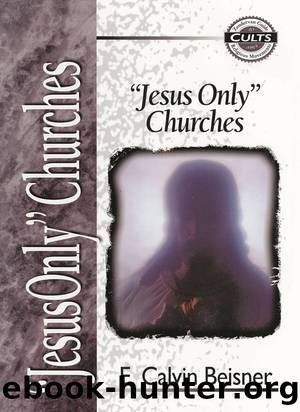Jesus Only Churches by E. Calvin Beisner

Author:E. Calvin Beisner [Beisner, E. Calvin]
Language: eng
Format: epub
Publisher: Zondervan
Published: 2016-07-02T00:00:00+00:00
1See, e.g., David K. Bernard, The Oneness of God (Hazelwood, Mo.: Word Aflame Press, 1983), 55â58.
2The 1992â1993 Pentecostal Publishing House catalog lists fifteen books and three audio tape series by Bernard, all on doctrinal subjects, with five of the books specifically on the doctrine of Oneness. The catalog lists no other author with nearly so many books on any subject, let alone on these specific subjects.
3Bernard, Oneness of God, 57; see also p. 216.
4Gordon Magee, Is Jesus in the Godhead or Is The Godhead in Jesus? (Hazelwood, Mo.: Word Aflame Press, 1988), 32.
5Bernard, Oneness of God, 117.
6Ibid., 103.
7Ibid., 103â4.
8Ibid., 106.
9Magee, Is Jesus, 25.
10Bernard, Oneness of God, 171.
11Ibid., 99â100.
12Ibid., 93.
13Ibid., 64.
14Magee, Is Jesus, 16.
15The contexts of Heb. 1:5 and 5:5 make it probable that in these instances the phrase âtoday I have begotten youâ (NIV note) refers not to Christâs incarnation but to his resurrection. If so, then this phrase never refers to his incarnation.
16Walter Bauer, A Greek-English Lexicon of the New Testament and Other Early Christian Literature, trans. William F. Arndt and F. Wilbur Gingrich, rev. F. Wilbur Gingrich and Frederick W. Danker, 2d ed. (Chicago: University of Chicago Press, 1979), 527; Henry G. Liddell and Robert Scott, comps., A Greek-English Lexicon, rev. Henry S. Jones and Roderick McKenzie et al., 9th ed. (Oxford: Oxford University Press, 1940), 1144; James H. Moulton and George Milligan, The Vocabulary of the Greek New Testament (reprint, Grand Rapids: Eerdmans, 1976), 417. As Bartels observes, âLit[erally monogenÄs] means âof a single kindâ, and could even be used in this sense of the Phoenix (1 Clem[ent] 25:2). It is only distantly related to gennaÅ, beget. The idea of âonly begottenâ goes back to Jerome who used unigenitus in the [Latin] Vulg[ate] to counter the Arian claim that Jesus was not begotten but made. [M]onogenÄs reflects the Heb[rew] yÄhîd of Isaac (Gen. 22:2, 12, 16) of whom it is used in Heb. 11:16â (Karl-Heinz Bartels, âOne,â in The New International Dictionary of New Testament Theology, ed. Colin Brown, 4 vols. [Grand Rapids: Zondervan, 1975â85], 2:725; hereafter abbreviated as NIDNTT).
17Bernard, Oneness of God, 66.
18This view resembles Apollinarianism, a view rejected by the church at the Council of Constantinople in A.D. 381 because it denied Christâs perfect manhood (J. F. Bethune-Baker, An Introduction to the Early History of Christian Doctrine to the Time of the Council of Chalcedon [London: Methuen and Company, 1903], 239â54).
19This view is akin to Nestorianism, which represented the divine Logos as dwelling in the man Christ Jesus, so that the union between the two natures was somewhat analogous to the indwelling of the Spirit, a view condemned by the church at the Council of Chalcedon in A.D. 451 because it effectively denied the incarnation and thus the deity of Christ and the sufficiency of the atonement to pay for sin. See Bethune-Baker, History, 255â80.
20My argument here follows that of Anselm. See his Cur Deus Homo? in A Scholastic Miscellany: Anselm to Ockham, ed. Eugene R. Fairweather, Library of Christian Classics (Philadelphia: Westminster, 1956), I.xx, xxi, xxv, II.
Download
This site does not store any files on its server. We only index and link to content provided by other sites. Please contact the content providers to delete copyright contents if any and email us, we'll remove relevant links or contents immediately.
| Baha'i | Cults |
| Demonology & Satanism | Eckankar |
| Egyptian Book of the Dead | Freemasonry |
| Messianic Judaism | Mysticism |
| Scientology | Theism |
| Tribal & Ethnic | Unitarian Universalism |
The Four Agreements by Don Miguel Ruiz(6322)
Breaking Free by Rachel Jeffs(4013)
The Hatha Yoga Pradipika (Translated) by Svatmarama(3077)
120 Days of Sodom by Marquis de Sade(2943)
Member of the Family by Dianne Lake(2262)
The Tao of Physics by Fritjof Capra(2168)
The Psychedelic Gospels: The Secret History of Hallucinogens in Christianity by Jerry B. Brown(2073)
The Road to Jonestown by Jeff Guinn(1983)
Going Clear: Scientology, Hollywood, and the Prison of Belief by Lawrence Wright(1884)
Going Clear by Lawrence Wright(1873)
Uriel's Machine by Christopher Knight(1823)
The Grand Grimoire: The Red Dragon by Author Unknown(1711)
The Gnostic Gospel of St. Thomas by Tau Malachi(1680)
Key to the Sacred Pattern: The Untold Story of Rennes-le-Chateau by Henry Lincoln(1556)
The Malloreon: Book 02 - King of the Murgos by David Eddings(1517)
Waco by David Thibodeau & Leon Whiteson & Aviva Layton(1488)
The New World Order Book by Nick Redfern(1485)
The Secret of the Temple by John Michael Greer(1422)
The Initiatory Path in Fairy Tales by Bernard Roger(1395)
